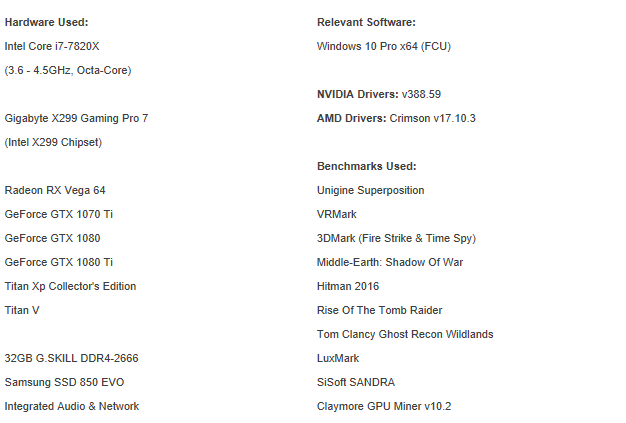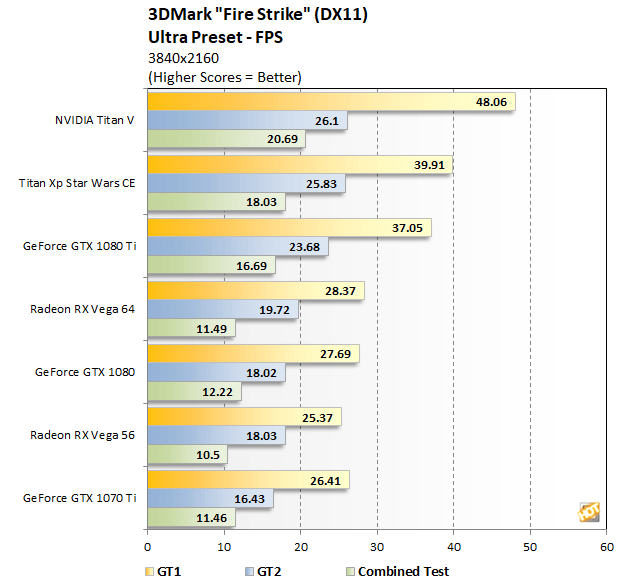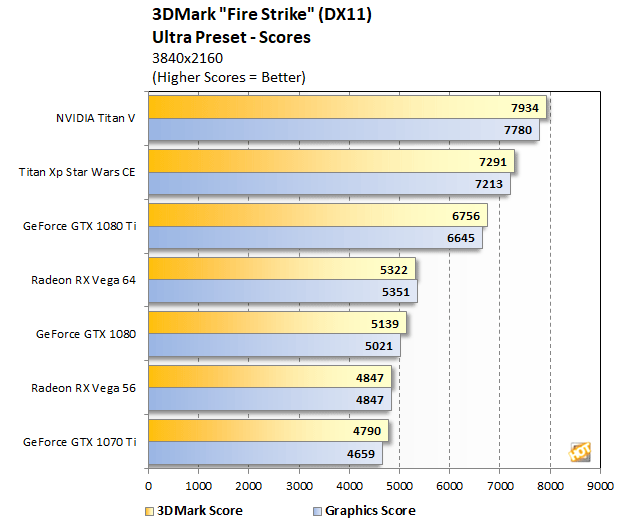NVIDIA TITAN V Review: Volta Compute, Mining, And Gaming Performance Explored
How We Configured Our Test Systems: We tested the graphics cards in this article on a Gigabyte Aorus X299 Gaming 7 Pro motherboard powered by an Intel Core i7-7820X octal-core processor and 32GB of G.SKILL DDR4 RAM clocked at 2666MHz. The first thing we did when configuring the test system was enter the UEFI and set all values to their "high performance" default settings and disable any integrated peripherals that wouldn't be put to use. The memory's clock was manually dialed in, to ensure optimal memory performance at the processor's maximum supported speed of 2666MHz (without overclocking) and the solid state drive was then formatted and Windows 10 Professional x64 was installed and fully updated. When the Windows installation was complete, we installed all of the drivers, games, and benchmark tools necessary to complete our tests.
We should note that the AMD Radeon RX Vega 64 was tested with its default "Balanced" power mode. Power Saver (slower) and Turbo (faster) power modes are also available with Vega-based cards, which would affect performance, noise output, and peak power consumption. In addition, it behooves us to say that the NVIDIA TITAN V IS NOT TARGETED AT GAMERS. The TITAN V is destined for AI and Machine Learning applications, and it is priced as such. The card is not specifically tuned for gaming and despite its killer performance (as you'll see); the value proposition for gamers is simply not practical. However, game performance of the TITAN V may give us a glimpse of what future consumer-targeted GPUs based on NVIDIA's Volta architecture may offer, and we're sure many of you reading this are curious as to what the card can do. Of course, we have an array of compute-focused tests on tap as well that are more targeted on the TITAN V's intended audience.|
|
|

|
|
|
Superposition is a new benchmark from Unigine, powered by the UNIGINE 2 Engine. It offers an array of benchmark modes, targeting gaming workloads as well as VR, with both DirectX and OpenGL code paths. There is an extreme hardware stability test built-in as well. Unigine Superposition uses the developer’s unique SSRTGI (Screen-Space Ray-Traced Global Illumination) dynamic lighting technology, along with high quality textures and models, to produce some stunning visuals. We ran Superposition in two modes using the DirectX code path – 1080p Extreme and VR Maximum -- to compare the performance of all graphics cards featured here.



NVIDIA's flagships GPUs are able to max-out the overall score in this benchmark (it's time to move onto VR Future mode), hence the grouping of 10K scores. If you look at the individual results, however, you'll see that the TITAN V offered measurably higher framerates and lower latencies than every other card we tested.
|

Futuremark VRMark


VRMark's Orange Room benchmark is mostly CPU-bound with a high-end GPU, hence the tight grouping here. Regardless, the TITAN V jumped out to yet another lead over every other card in the mix.
|

3DMark Time Spy


|
|
|
The TITAN V held onto small leads in the Combined and Game Test 2 portions of this benchmark, but it was markedly faster than every other card in Game Test 1. With how the scores are weighted though, the TITAN V ends up finishing about 10% higher than a TITAN Xp.













